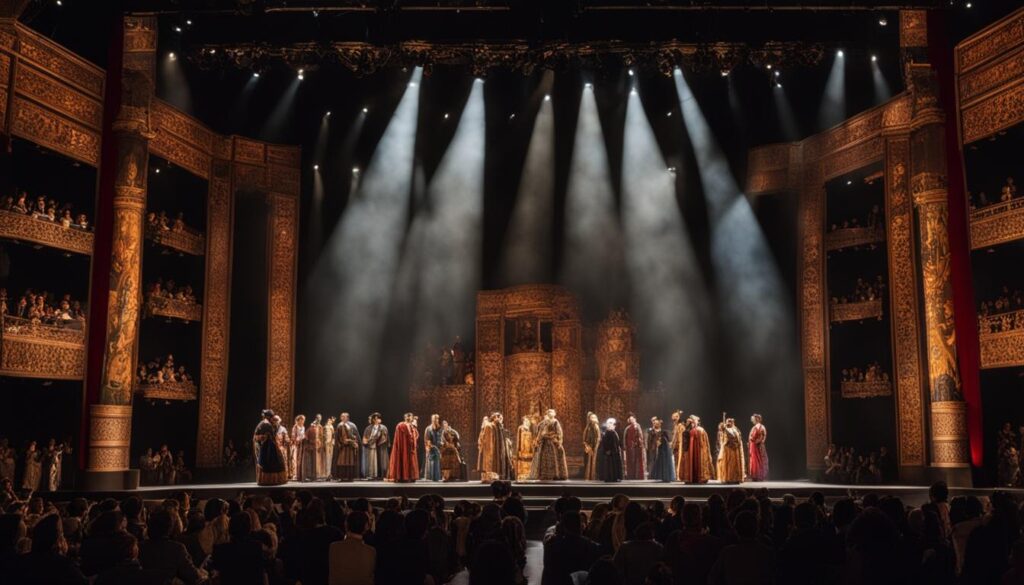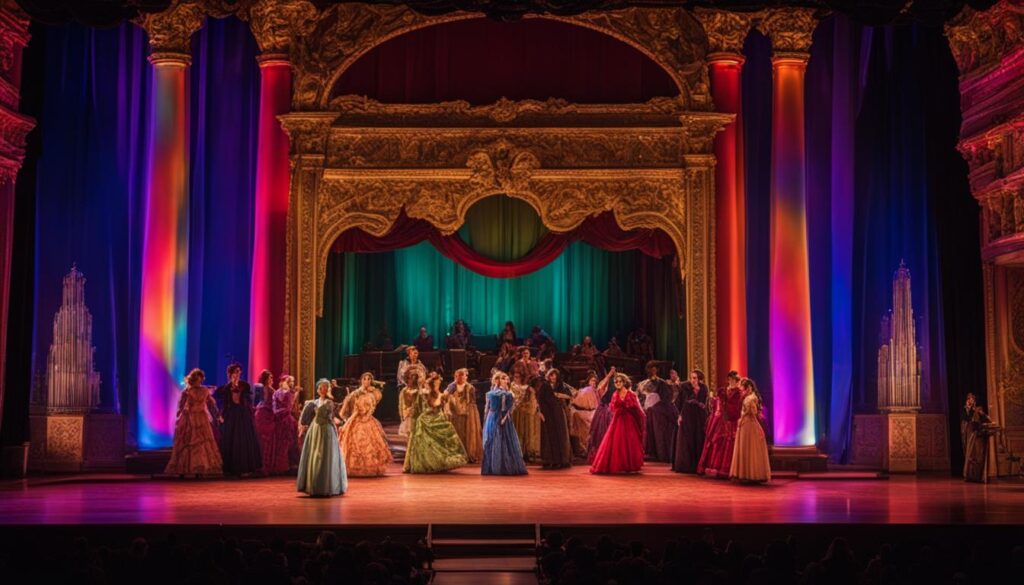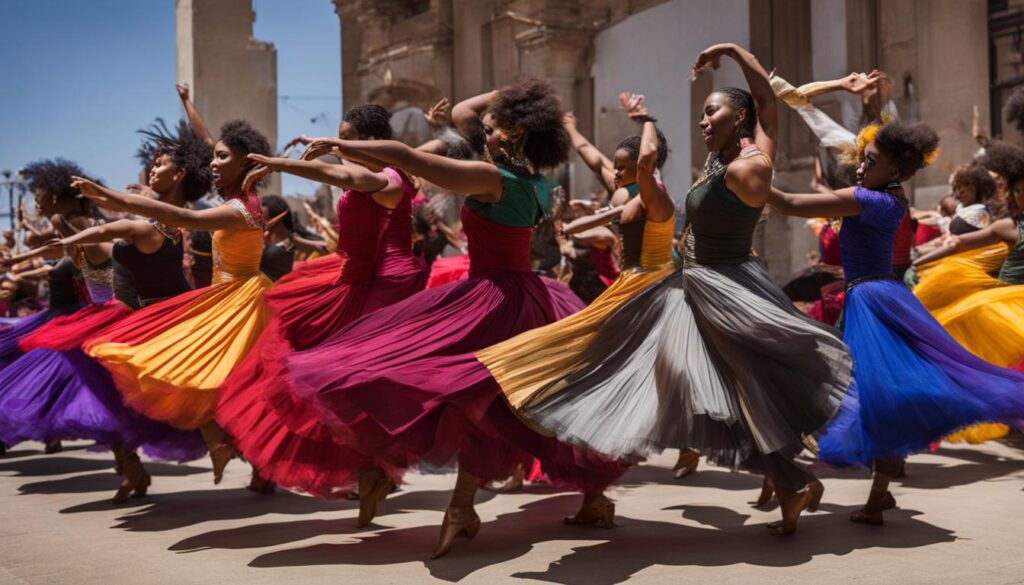I am thrilled to explore the enchanting world of theatre and its role in the performing arts. Theatre, an art form that has stood the test of time, has captivated audiences for centuries with its ability to transport us to distant worlds, evoke deep emotions, and tell compelling stories. Today, we will delve into the definition of theatre, its historical evolution, its magical elements, its reflection of society, and the profound impact it has on our lives.
Key Takeaways:
- Theatre is an art form that transports audiences and tells captivating stories.
- The history of theatre dates back to ancient Greece and has evolved over time.
- Theatre comprises various elements and techniques that create a captivating experience.
- Theatre reflects society and addresses social and political issues.
- The impact of theatre on society is profound, fostering empathy, connection, and change.
The History and Evolution of Theatre
Theatre has a rich history that spans centuries, and its evolution has shaped the performing arts landscape as we know it today. From its origins in ancient Greece to its contemporary forms, theatre continues to captivate audiences worldwide.
In ancient Greece, theatre was a central part of religious festivals, with performances staged to honor the gods. Tragedies, comedies, and satyr plays were the three main types of theatre, each with its own style and purpose. Tragedies, such as the works of Sophocles and Euripides, explored themes of human suffering and the consequences of hubris. Comedies, on the other hand, provided light-hearted entertainment and often satirized social and political issues. The emergence of musical theatre brought together elements of music, dance, and storytelling, creating a vibrant and immersive theatrical experience.
Theatre techniques have evolved alongside its historical development. Improvisation, for instance, allows actors to create dialogue and actions spontaneously, adding an element of unpredictability to performances. Physicality, another key technique, emphasizes the expressive use of the body to convey emotions and tell stories. The art of storytelling has always been at the heart of theatre, transporting audiences to different worlds and inviting them to engage with diverse characters and narratives.
To showcase the historical timeline and diversity of theatre, here is a table highlighting some key theatrical forms and their characteristics:
| Theatre Form | Characteristics |
|---|---|
| Greek Tragedy | Exploration of human suffering and moral dilemmas |
| Commedia dell’arte | Masked comedy with stock characters and improvised dialogue |
| Kabuki | Japanese traditional theatre with elaborate costumes and stylized movements |
| Brechtian Theatre | A style that emphasizes political and social themes, breaking the fourth wall |
| Musical Theatre | Integration of music, dance, and dialogue to tell stories |
Through centuries of development, theatre has left an indelible mark on the performing arts. Its ability to entertain, educate, and provoke thought makes it a truly magical form of expression.


The Elements and Magic of Theatre
Theatre is a dynamic art form that combines various elements to create a truly magical experience for both performers and audiences. From the intricacies of acting and writing to the grandeur of set design and lighting, each element plays a vital role in bringing a theatrical production to life.
Acting is at the heart of theatre, with actors embodying characters and using their skills to convey emotions, tell stories, and connect with the audience. The art of acting involves mastering techniques such as voice modulation, physicality, and the ability to fully immerse oneself in a character’s world.
Writing, on the other hand, provides the foundation for a compelling theatrical piece. Playwrights craft scripts that explore diverse themes, delve into complex relationships, and offer thought-provoking insights into the human condition. The power of words in theatre lies in their ability to evoke emotions, spark imagination, and ignite meaningful conversations.
Directing brings all the elements of theatre together, guiding the actors, shaping the vision, and ensuring a cohesive and impactful production. Directors make decisions about casting, staging, and overall artistic direction, playing a crucial role in translating the writer’s vision into a captivating performance.
Table: Theatre vs. Drama
| Theatre | Drama | |
|---|---|---|
| Definition | A performing art that involves live performances and direct interaction with the audience | A genre of literature that focuses on dialogue and performance, but can also encompass other forms of storytelling |
| Medium | Live performances in a designated space (theater) | Can be performed on stage or in other mediums, such as film or television |
| Emphasis | Visual and auditory elements, including acting, set design, lighting, and sound | Written text and dialogue, with less focus on visual and auditory elements |
| Interaction | Direct engagement with the audience, allowing for immediate response and connection | Indirect engagement with the audience through the written text |
Set design, lighting, and sound are crucial elements that contribute to the overall atmosphere and ambiance of a theatrical production. Set designers create visually stunning and functional sets that transport the audience to different times and places. Lighting designers use their craft to manipulate light and shadows, setting the mood and highlighting key moments. Sound designers enhance the auditory experience, using music, sound effects, and ambient sounds to enrich the storytelling.
The magic of theatre lies in its ability to inspire, challenge, and entertain. It fosters a deeper understanding of the human experience and allows for personal connections between the performers and the audience. Theatre has the power to provoke emotions, provoke thought, and create lasting memories. By utilizing the various elements of theatre, artists can create transformative experiences that touch the hearts and minds of those who witness them.


Theatre as a Reflection of Society
Throughout history, theatre has played a vital role in reflecting the social, political, and cultural aspects of society. It has served as a powerful medium for playwrights and performers to raise awareness, challenge societal norms, and provoke thought-provoking conversations. Theatre has the unique ability to mirror the joys, struggles, and triumphs of humanity, providing audiences with a glimpse into the complexities of the human experience.
One of the significant ways in which theatre reflects society is through its exploration of social and political issues. Playwrights have used their scripts to shine a spotlight on topics such as inequality, discrimination, war, and human rights abuses. By tackling these subjects head-on, theatre has the power to provoke audiences, encouraging them to question the status quo and contemplate their own roles within society.
“Theatre is a mirror, a sharp reflection of society.” – Augusto Boal
Theatre also serves as a platform for different theatrical cultures to showcase their unique styles and traditions. Cultures from around the world bring their own storytelling techniques, music, dance, and performance rituals, creating a diverse tapestry of theatrical experiences. From the vibrant costumes and energetic movements of traditional African theatre to the stylized gestures and intricate masks of Japanese Noh theatre, these theatrical cultures offer a valuable insight into the rich tapestry of human heritage.
As theatre continues to evolve and adapt to contemporary issues, it remains an essential medium for societal reflection. By presenting stories and characters that resonate with audiences, theatre fosters empathy, understanding, and connection. It allows individuals to see themselves and their experiences reflected on stage, fostering a sense of community and shared humanity.
| Theatrical Culture | Key Characteristics |
|---|---|
| African Theatre | Emphasizes community participation, energetic performances, and vibrant costumes. |
| Noh Theatre | Incorporates stylized movements, intricate masks, and ancient storytelling traditions. |
| Russian Theatre | Known for its psychological depth, symbolism, and experimental theatre techniques. |
| Broadway Theatre | Showcases grand-scale musical productions, extravagant sets, and high-energy performances. |
Conclusion
The magic of theater is a captivating force that transcends time and connects us on a profound level. It has the power to transport us to different worlds, evoke a range of emotions, and ignite our imaginations.
The impact of theater on society cannot be overstated. Through its stories, characters, and performances, theater has the ability to challenge our perspectives, foster empathy, and inspire change. It serves as a powerful catalyst for social, cultural, and political discussions, sparking conversations that have the potential to shape our collective consciousness.
As theater continues to evolve and adapt to the ever-changing world, its magic remains constant. It is a testament to the enduring power of storytelling and the human need for connection. Whether we are performing on stage or sitting in the audience, theater has the ability to enrich our lives and remind us of our shared humanity.
The magic of theater will always endure, as long as there are stories to be told and hearts to be touched. It is a celebration of our creativity, resilience, and capacity for empathy. Let us embrace the transformative power of theater and allow it to inspire, challenge, and connect us.
FAQ
What is theatre in performing arts?
Theatre is an art form that has evolved over centuries, captivating audiences with its ability to transport them to distant worlds, evoke emotions, and tell captivating stories.
What is the history of theatre?
Theatre has a rich history that can be traced back to ancient Greece, where it was an integral part of religious festivals. Over the centuries, different types of theatre have emerged, including tragedies, comedies, and musicals. Theatre techniques have also evolved, incorporating elements such as improvisation, physicality, and storytelling.
What are the elements of theatre?
Theatre comprises various elements that come together to create a captivating experience for the audience. These elements include acting, writing, directing, set design, lighting, and sound. Theatre differs from drama in that it involves live performances and direct interaction with the audience. The importance of theatre in performing arts lies in its ability to inspire, challenge, and entertain, fostering a deeper understanding of the human experience.
How does theatre reflect society?
Throughout history, theatre has served as a mirror of society, reflecting its joys, struggles, and triumphs. Playwrights have used theatre as a platform to address social and political issues, challenging the status quo and sparking conversations. Different theatrical cultures around the world have contributed unique styles and traditions, showcasing the diversity of storytelling and performance.
What is the impact of theatre on society?
Theatre holds a magical quality that transports audiences to different worlds and evokes powerful emotions. Its impact on society is profound, serving as a catalyst for change, empathy, and connection. Theatre continues to evolve and reinvent itself, captivating and enriching the lives of both performers and audience members. The magic of theatre will always endure as long as there are stories to be told and hearts to be touched.

